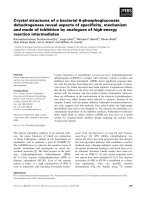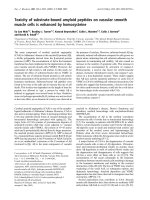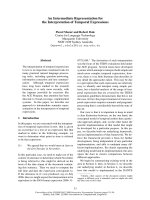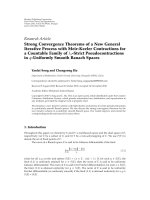- Trang chủ >>
- Khoa Học Tự Nhiên >>
- Vật lý
GLAUBER TYPE REPRESENTATION FOR THE SCATTERING AMPLITUDE OF HIGH ENERGY DIRAC PARTICLES ON THE SMOOTH POTENTIAL
Bạn đang xem bản rút gọn của tài liệu. Xem và tải ngay bản đầy đủ của tài liệu tại đây (241.91 KB, 7 trang )
Proc. Natl. Conf. Theor. Phys. 35 (2010), pp. 202-208
GLAUBER TYPE REPRESENTATION FOR THE SCATTERING
AMPLITUDE OF HIGH-ENERGY DIRAC PARTICLES
ON THE SMOOTH POTENTIAL
NGUYEN SUAN HAN, LE THI HAI YEN
Department of Theoretical Physics, Vietnam National University, Hanoi
Abstract. By the functional integration method the deduction of the Glauber-type representation
for scattering amplitude of the spin of particles on the smooth potential is performed. This method
generalizing the usual operation of taking the square of the Dirac equation is proposed for obtaining
the functional integral representation of the amplitude. It has shown that the scattering amplitudes,
which have obtained by moving to shell mass, of normal Green function and quadratic Green
function, are the same types, and taking into account of spin of particles leads to new term which
is responsible for the spin flip in the scattering processes.
I. INTRODUCTION
The eikonal approximation for the potential scattering amplitude of high-energy
and small scattering angles has been investigated by many authors /1-5/. In fact these
investigations do not take into account the spin structure of the scattered processes. It
has become however well known from experiment that spin effects are of great interest in
many processes /5, 6/. Therefore, in this paper we consider the problems generalizing the
eikonal approximation with the view to taking into account spin effects, namely we consider
the scattering of the Dirac particles on the smooth potential. The exposition proceeds as
follows: In the second section we present a method to find exact closed form expression for
the Dirac particle Green function in a smooth potential in the formwork of the functional
approach. Then by transitioning to the mass shell of the external one particle Green’s
function we obtain a closed representation for the potential scattering amplitude expressed
in the form of functional integrals. For estimating the functional integrals we used the
straight line path approximation based on the idea of rectilinear paths of the interacting
particles at asymptotically high-energy and small scattering angles. Section 3 is devoted to
investigating the asymptotic behavior of this amplitude in high energy and small scattering
angles. Finally we discuss the obtained results and possible generalizations of the approach
into quantum gravity /6-11/.
II. CLOSED EXPRESSION FOR SCATTERING AMPLITUDE IN THE
FORM OF THE FUNCTIONAL FORM
Following /1, 6/ the scattering amplitude of the Dirac particles in the external
smooth arbitrary potential , is defined by the formula
˜ =
F p, q|A
1
u
¯(p)
2m
lim
p2 ,q2 →m2
˜
(p2 −m2 ) q2 −m2 Gλ q, p|A
u(q),
(1)
GLAUBER TYPE REPRESENTATION FOR THE SCATTERING AMPLITUDE OF...
203
where spinors u
¯(p) and u(p) on the mass shell p2 −m2 and q2 −m2 , satisfied the Dirac
equation and the normalization condition u
¯(p)u(p) = 2m;
˜ = iγ µ ∂µ +m + λA(x)
˜
˜ ,
G x, y|A
Gλ x, y|A
˜ of particle in the external smooth arbitrary potential , and
the Green function Gλ (x, y|A)
satisfied the quadratic Dirac equation,
iγ µ ∂µ
2
2
(4)
˜
˜
+2˜
a(λ)
µ i∂µ +Φλ −m Gλ x, y|A = −δ (x − y),
(2)
1 ˜
˜
˜ + λA
˜ 2 , ˜a(λ)
˜ λ = m(1 − λ) + λiγ ∂µ A
Φ
µ = 2 Aγ µ +λγ µ A , where λ is an arbitrary number,
µ
the Green function G(x, y|A) satisfies the Dirac equation
˜
˜ = −δ (4) (x − y).
G x, y|A
iγ µ ∂µ −m + A(x)
(3)
Note that the choice of the parameter λ is arbitrary and does not effect the physical results, and can be set at any convenient values. In appendix A we show the expression
2
2
˜
˜
d4 xd4 yeipx−iqy A(x)G
λ x, y| A = 0 has no poles at p = m . The Green function of
˜ and the Green function of the equation (3) G(x, y|A)
˜ in the
the equation (2) Gλ (x, y|A)
2
2
2
2
mass shell p −m and q −m , respectively, as it is shown, give the same scattering
amplitude. The equality of expressions for these above amplitudes by mean of the perturbation theory is proven in appendix B. Using the closed expressions for Green functions
˜ obtained in form functional integrals, we separate out from the Green function
Gλ (x, y|A)
˜ with the poles p2 −m2 −1 and q2 −m2 −1 which cancel against the factors in
Gλ (x, y|A)
Eq (1) as we have done in /1, 5, 6/, for the scattering amplitude. We find the following
expressions:
∞
t
M(x|ξ)
iα
1
∞
˜ =
u(q), (4)
dαe −∞
u
¯(p) d4 xei(p−q)x
δ 4 ν −∞ Tγ M(x|0)
F p, q|A
2m
0
˜ λ (xξ ) − a
M (x|ξ) = [2ν(ξ) + a(ξ)] a
˜(λ) (xξ ) + Φ
˜(λ)2 (xξ ) − i∂˜
a(λ) (xξ ),
ξ
xξ = x + [2pθ(ξ) + 2qθ(−ξ)] ξ + 2
ν(η)dη;
(5)
0
∞
1, ξ > 0,
1/2, ξ = 0,
θ(ξ) =
0, ξ < 0,
δνexp −i
[δν]∞
−∞ =
ν 2 (ξ)dξ
−∞
(6)
∞
ν 2 (ξ)dξ
δνexp −i
−∞
Tγ is the symbol of ordering the gamma matrices with respect to the variable ξ.
204
NGUYEN SUAN HAN, LE THI HAI YEN
III. ASYMPTOTIC BEHAVIOR OF THE SCATTERING AMPLITUDE
AT HIGH ENERGY
For the calculation of the functional integrals (4) we use the straight line path
approximation, i.e. we assume that in the high energy particle scattering on the smooth
potential and small scattering angles, one can neglect the dependence on the functional
variables ν(η). In other words, it is considered that the main contribution to the functional
integrals (4) comes from a trajectory particle moving freely from the momentum p
˜ with
ξ > 0 and momentum q
˜ with ξ < 0, and passing via the point x with ξ = 0.
√
√
¯ (1,˜
˜p
˜/|˜
p|) Ψq m, |˜
p| ≈ |˜
q| ,
(7)
u
¯(p) = Ψ
σp
˜/|˜
p|) m; u(q) = (1, σ
p
¯ p and Ψq are ordinary two-component spinors. To choose the symbol xµ = (t, r);
where Ψ
r = (z, x⊥ ) then the z- axis is chosen along the vector p. Note that the approximate
results above shown the scattering amplitude we can notify the eikonal representation of
amplitude
F(p, q) = 2πδ(p0 −qo )f (p, q)
¯p
f (p, q) = −ipz Ψ
¯
d2 x⊥ eix⊥ (p−q) Γ(x
⊥ ) − 1 Ψq
1
ˆγ
iX
¯
Γ(x
⊥ ) = (1, σ z )Tγ e
2
1
σz
(8)
(9)
∞
ˆ γ (˜
X
x⊥ ) =
−∞
dz
2p˜a(λ) (r)+ Φλ (r) + i∂˜a(λ) (r)
2pz
(10)
˜ λ is defined by Eq (2). When po → ∞ to p˜a(λ) ≈ p0 , all terms, which do not
where ˜a(λ) , Φ
depend on energy in square brackets of the expression (10), can be ignored we obtain
∞
ˆ γ (˜
X
x⊥ ) =
−∞
dz (λ)
p˜a (r)
pz
(11)
When accepting the formula (8,9,10) in the Eq. (4) we have applied a replacement
ˆ γ (˜
2pz ξ = z, assuming the matrix in X
x⊥ ) which will depend on z in the ordering variables. Using the arbitrariness in the value parameter squared λ, for simplicity of the
expression ˜
aλµ it is convenient to choice λ = 1, λ = −1. Other choice λ only complicates
the calculations. Let us consider a now some concrete potential; in first case we consider
(+)
the vector potential ˜
aµ = Aµ (x) whose 4-components satisfy the condition pA ≈ 0 (p0 ).
For phase χ there is the right formula (11). In scattering on vector potential we have,
∞
Γ (˜
x⊥ ) = e
iχ(ρ)
, χ (˜
x⊥ ) =
−∞
dz
pA (r)
pz
(12)
in asymptotic the scattering amplitude fully do not depends the spin. This expression is
agreed with result obtained in / 8/. In second case we consider the scattering of particle
GLAUBER TYPE REPRESENTATION FOR THE SCATTERING AMPLITUDE OF...
205
˜ = σ µν Fµν .
with anomaly magnetic moment in external electromagnetic field A
1
1 ˜
˜
Fµν = (∂µ Aν −∂ν Aµ ) , a˜(−)
A(x)γ µ −γ µ A(x)
, Aµ = (0, 0, 0, −U)
µ =
2
2
(13)
The arrangement of the γ- matrix in the above equation (9) and (10) becomes impossible.
ˆ -matrix we find
For Γ
∞
1
p0
pz
1
¯
Γ(x
)
=
dz
γ(z)n
∂
U(r)+
γ
−γ
∂
U(r)
(1,
σ
)
T
exp
i
(14)
ρ
3
z
γ
0
z
⊥
pz
σz
2
p0
−∞
Note that, the expansion of the last expression (14) in a series in powers of γ3 −γ 0 pp0z
actually respect to γ3 −γ 0 pp0z
2
is
2
since
= −m
p2
z
(1, σ z ) γ3 −γ 0
pz
p0
1
σz
= 0.
Therefore, the second term in the argument of the exponent in (14) can be ignored altoˆ we have
gether. Then for Γ
∞
2
2p0
ˆ
Γ(x
⊥ ) = chχ(ρ)+ [n × σ]z sh χ, χ(ρ) =
pz
dz∂ρ ϕ(r)
(15)
−∞
After substitution of (14) into (8) and integration in (8) by angle variable can be readily
performed, and for the scattering amplitude we find
¯ [f0 (|p − q|) + (σ · m)f (|p − q|)] Ψq ;m =
f(p, q) = Ψ
p
1
p×q
,
|p × q|
(16)
where f0 (|p − q|) = f0 (∆) and f1 (|p − q|) = f1 (∆) describe processes without and with
spin flip, respectively, and they are given by,
∞
pz
f0 (∆) =
2πi
ρdρJ0 (ρ∆) [ch χ(ρ) − 1],
(17)
0
∞
pz
f1 (∆) =
2π
ρdρJ1 (ρ∆)sh χ(ρ).
(18)
0
Comparing the results (15,16,17,18) that have been obtained with those of other authors,
those resulted in our work has shown that spin of particles leads to new term which is
responsible for spin flip in the scattering processes. They have been outstanding. The
results obtained here can be applied in quantum gravity, as they here are similar to those
we see in the scattering of Dirac particle in the gravitational potential /6-11/ in near
future.
206
NGUYEN SUAN HAN, LE THI HAI YEN
ACKNOWLEDGMENT
This work was completed with financial support by the Vietnam National University
under Contract No QGTD 10.02.
REFERENCES
[1]
[2]
[3]
[4]
[5]
[6]
[7]
[8]
[9]
V. N. Pervushin, TMF 4 (1970) 22; 9 (1971) 264.
L. I. Schiff, Phys. Rev. 103 (1956) 443; A. Baker, Phys. Rev. 134 (1964) 240.
S. V. Goloskokov, S. P. Kuleshov, V. K. Mitryushkin, M. A. Smondyres, TMF 24 (1975) 147.
W. Dittrich, arXiv:hep-th/0010235.
Nguyen Suan Han, JINR 2 (1975) 8750.
Nguyen Suan Han, V. N. Pervushin, J. of Theor. and Phys. 29 (1976) 1003.
Nguyen Suan Han, Eap Ponna, Nuovo Cimento A 110 (1997) 459.
Nguyen Suan Han, European Physical Journal C 16 (2000) 547.
Nguyen Suan Han, Nguyen Nhu Xuan, European Physical Journal C 24 (2002) 643 [arXiv:grqc/0203054].
[10] Nguyen Suan Han, Nguyen Nhu Xuan, arXiv:0804.3432, to be published in European Physical Journal C.
[11] Andreas Ross, Barry R. Holstein, J. Phys. A: Math. Theor. 40 (2007) 6973.
APPENDIX A
In this section, we will prove that the expression
˜
˜
d4 xd4 yeipx−iqy A(x)G
λ x, y| A
has no poles at p2 = m2 , it means,
J=
˜
˜
d4 xd4 yeipx−iqy A(x)G
λ x, y| A = 0
p2 − m2
lim
p2 ,q2 →m2
(19)
To eliminate pole p2 = m2 we use the functional integral representation in quadratic Green
function:
∞
s
dse−im
˜ =i
Gλ x, y| A
2s
[δν]s0 C [ν]s0 δ 4 x − y − 2
0
ν (η) dη
(20)
0
s
˜ (xξ ) − ˜a2 (xξ ) − i∂˜a (xξ )
where, C [ν]s0 = Tγ exp i dξ 2ν˜a (xξ ) + Φ
with xξ = x +
0
ξ
2 ν (η) dη. We have calculated previous integral by Delta-function over x-variable, and
0
subtituted ν(ξ) → ν(ξ) + p.
s
s
(ν (η) + p) dη = ps +
Because of
0
and by using formula
ν (η) dη
0
lim
ε→0,
p2 →m2
p2 − m2 i
∞
0
2
dseis(p
−m2 )−εs
f (s) = f (∞),
GLAUBER TYPE REPRESENTATION FOR THE SCATTERING AMPLITUDE OF...
207
s
[δν]s0
with
s
˜ y + 2ps + 2 ν (η) dη e
d4 yei(p−q)y A
0
ip2
ν(η)dη
0
C [ν + p]s0 , where f (s) is a
s
˜ y + 2ps + 2 ν (η) dη
limited function and limit limA
= 0 as in the scattering problem
0
˜ (∞) = 0. So that (19) is equal to zero.
A
APPENDIX B
We will prove that the scattering amplitudes, which have obtained by moving to
mass shell, of ordinary and quadratic Green functions are the same types by perturbation
theory in this section Let consider the third term of (1) which can be performed:
˜ =u
¯(p)
2mF(3) p, q| A
d4 k1 d4 k2 L(3) + K(3) u(q),
(21)
where, L(3) is corresponding with the linear interaction in potential
˜ = m (1 − λ) + λi∂˜x A
˜ + iA
˜ ∂ˆx
2˜
aµ i∂µ + Φ
2
˜ . The expression of linear potential
and K (3) ) is contribution of quadratic potential λA
L(3) is:
L(3) =
ˆ1 + m + λ (ˆ
˜1 p
˜1
A
ˆ+k
p − m) A
ˆ1 + k
ˆ2 + m A
˜ 3 (m + q
˜3
A
ˆ) − λ p
ˆ+k
ˆ1 + m A
˜2 ×
−λ p
ˆ+k
˜ 1,2 = A
˜ (k1,2 ) ; A
˜ (k) =
with A
L
m2 − (p + k1 + k2 )2
ˆ1 + m
˜ (x); A
˜3 = A
˜ (−k1 − k2 − p + q) and p
d4 xeikx A
ˆ+k
ˆ1 + k
ˆ2 + m
= m2 − (p + k1 )2 ; p
ˆ+k
(3)
˜2 p
ˆ1 + k
ˆ2 + m −
h
ˆ+k
m2 − (p + k1 )2
2
= m2 − (p + k1 + k2 )2 , so we have
ˆ1 + m A
ˆ1 + k
ˆ2 + m A
˜1 p
˜2 p
˜3
2mA
ˆ+k
ˆ+k
=
m2 − (p + k1 )2
m2 − (p + k1 + k2 )2
˜ 1A
˜2
−λA
−
ˆ1 + k
ˆ2 + m
2m − λ p
ˆ+k
ˆ1 + m A
˜1 p
˜ 2A
˜3
λA
ˆ+k
m2 − (p + k1 )2
˜3
A
(22)
m2 − (p + k1 + k2 )2
Let us consider the expression of K (3) ):
K (3) = λ
A˜1 pˆ + kˆ1 + m A˜2 A˜3
m2 − (p + k1 )2
+λ
−
2mA˜1 A˜2 A˜3
m2 − (p + k1 + k2 )2
−
2
208
NGUYEN SUAN HAN, LE THI HAI YEN
−λ2
A˜1 A˜2 pˆ + kˆ1 + kˆ2 + m A˜3
m2 − (p + k1 + k2 )2
It is easy to realize that two latter term of (22) are equal to K (3) ) with opposite sign. So
(21) becomes:
˜ =u
F(3) p, q| A
¯(p)
d4 k1 d4 k2
ˆ1 + k
ˆ2 + m A
ˆ1 + m A
˜3
˜2 p
˜1 p
ˆ+k
A
ˆ+k
m2 − (p + k1 )2
m2 − (p + k1 + k2 )2
u(q)
And it coincides with the third term of the expression of scattering amplitude, which has
obtained by moving to mass shell of ordinary Green function.
Received 15-09-2010.









